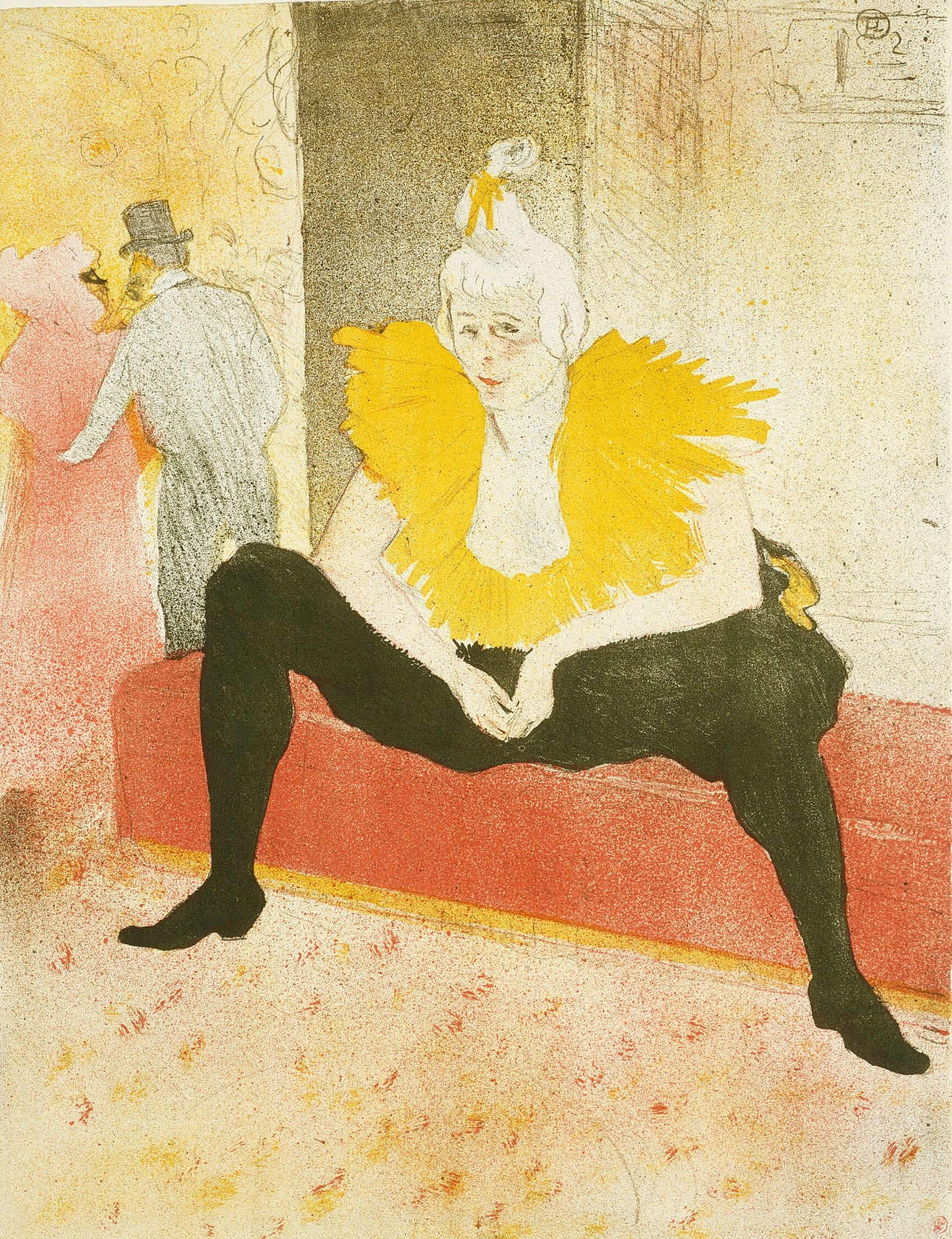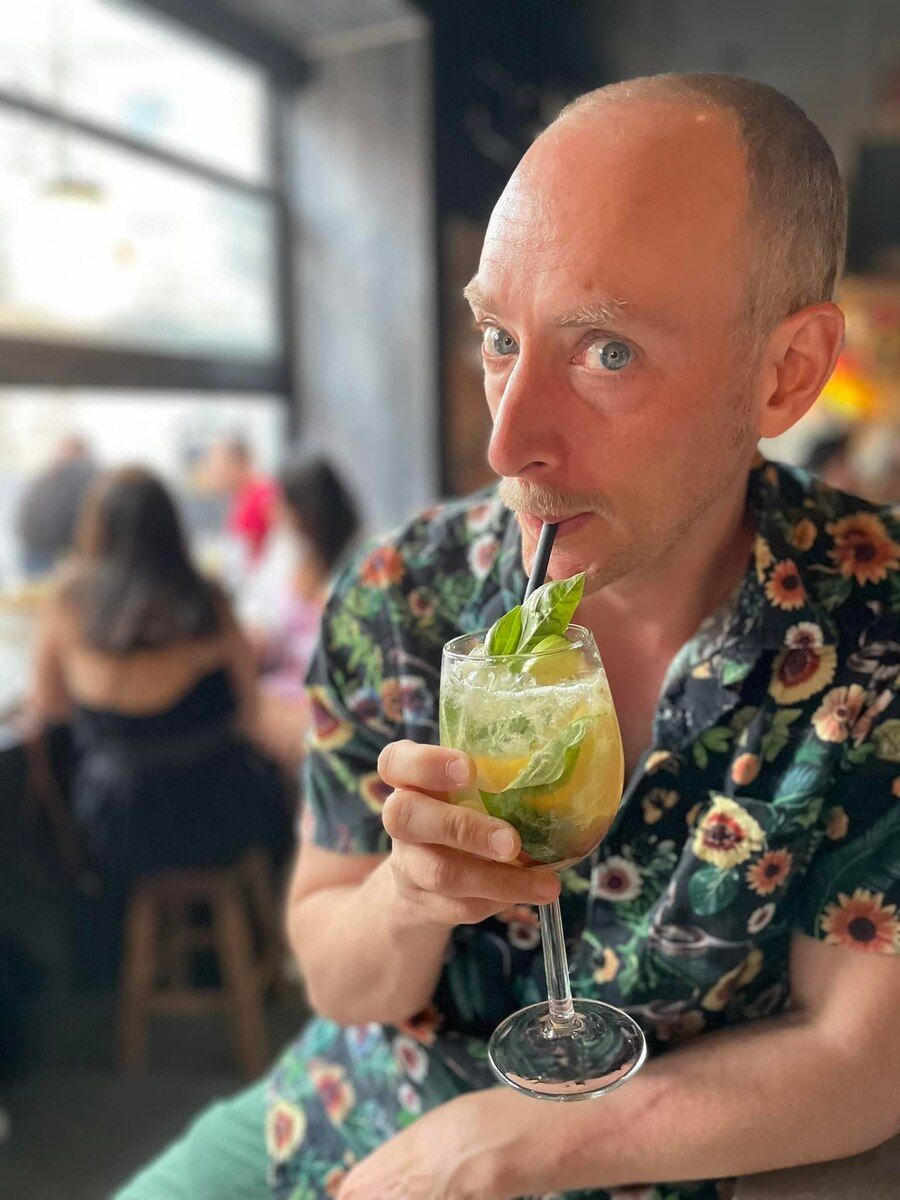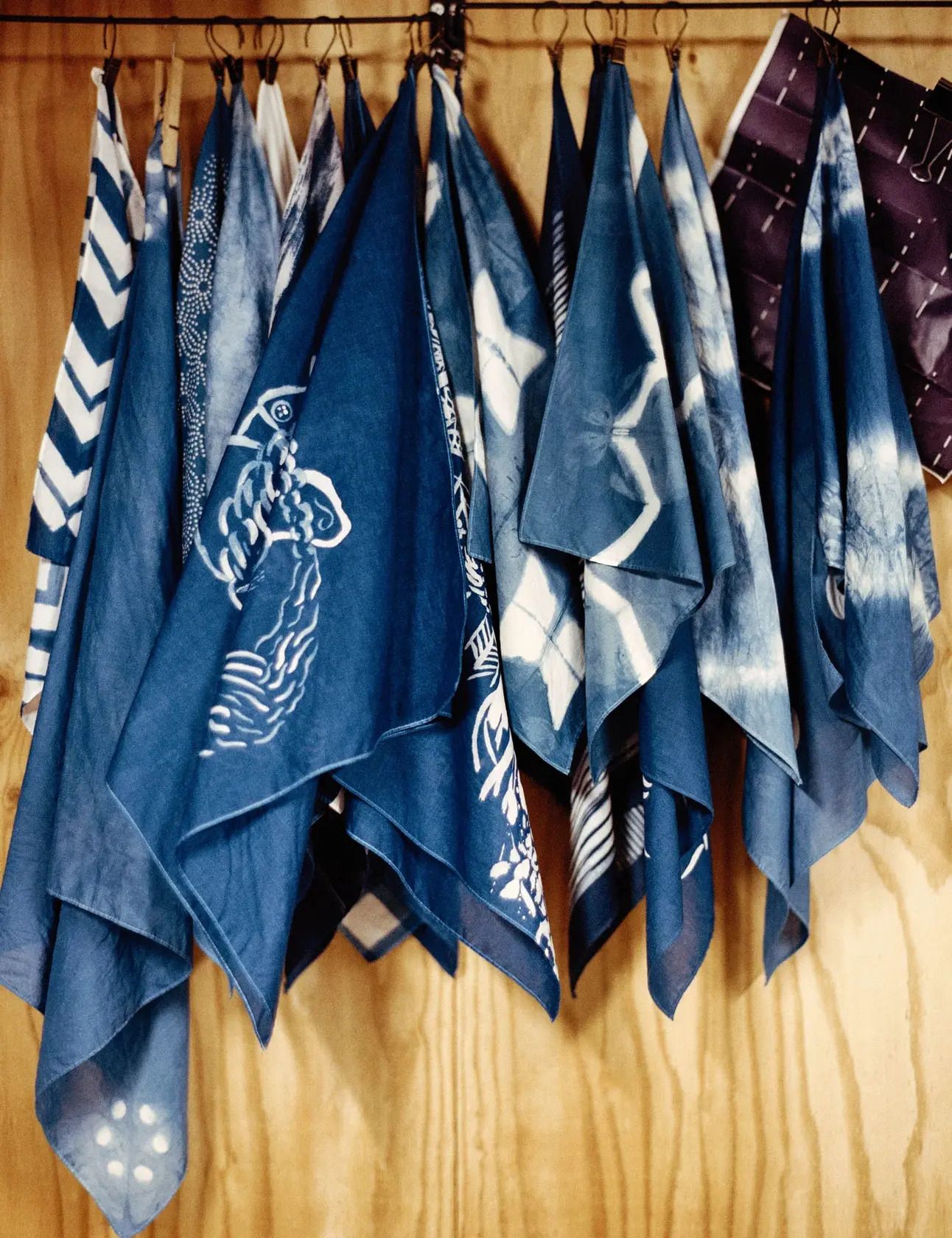
“Seated Female Clown (Mademoiselle Cha-U-Kao)” (1896), by Henri de Toulouse-Lautrec.
Once upon a time, I was 5 feet 8 inches tall. I can’t tell you the precise moment I realized I’d hit that height, but it was probably at my final pediatrician appointment, somewhere around the time I turned 18. I do remember, however, the relief and exaltation I felt at hearing, at knowing that number. Not only was I one inch taller than my father, I had reached the lower end of the average height spectrum for American men born in the mid-1970s! This was a miracle. I had grown up short, always the second-smallest kid in my classes, and never experienced the growth spurts, muscle development, voice cracking, and sudden hairiness that sex-ed classes promised. Instead, I matured stealthily, inch by slow inch, one reluctant follicle at a time, until now, about to head off to college, I was at last—average!
Luckily, my size never affected how I dressed. Because I dressed poorly. I wore what teens wore then, which is what teens wear now: baggy T-shirts, baggy jeans, clompy sneakers, hooded sweatshirts. The tops were often adorned with the names of bands or skateboard companies I idolized, and the bottoms were from thrift stores. There are not many photos of me from that era, but the ones that survive depict a shapeless young man with glasses and a full head of hair. I remember my father once explaining that in his day, guys wore tight clothes to show off “what they had” to girls; I countered that my baggy clothes instead created an air of mystery—and there was only one way to discover what might lurk beneath my Limpies.
And what was under there? Silk boxers, for one, shoplifted by my friends from area malls. But mostly just a pale young man, skinny but already with a small spare tire that adorns him even now. It was a body that most of humanity is glad remained clothed in public.
Over the years, I began to dress a little better. While working in Vietnam after college, I felt pressure to look more grown-up and professional. My friend Tuyen gave me good advice: You should tuck your shirt in, he said. Huh. I had never considered that. I tucked my shirt in. Another friend, Ian, gave me a pile of nice (and allegedly authentic) Valentino shirts—they were a little baggy, but they were also the kind you’d want to tuck in. I moved to New York City and, following the lead of my friend Tony, joined a gym; if I was going to date anyone here, I thought, I should at least try to provide a satisfying answer to the mystery of me. I began dating (and later married) Jean, a fashion designer, and discovered I enjoyed paying attention to her world: W and Vogue and Visionaire, silhouettes and ruching. There was a whole constellation of designers whose profiles matched up with the movies and literature and music I loved—too intellectual and abstract to be part of the mainstream, yet not radical or avant-garde enough to fully occupy the category of Art.
I went through a brief fancy period, back when we all had to look decent at the office. Eredi Pisano made stylish suits and shirts, at relatively affordable prices; I wore a size 36, about as small as you can get. I bought an all-white blazer from Barneys that I never had tailored and still sits in its garment bag in my closet. And I lusted after the modern-Edwardian suits made by Paul Harnden, a reclusive Brit whose prices were always just out of my reach. I don’t know if I looked good in this era, or any of my eras, but I think I looked better—more nearly like myself.
By the time I first visited Japan in 2007, I was attuned enough to fashion to appreciate what Tokyo and Osaka had to offer: better made, more experimental versions of what I already loved—and in my size! Granted, in Japan I was an L rather than an S, but that only increased the availability of garments at places like Kapital, because small sizes (as I’d learned over the years) tend to sell out way faster than the bigger ones. We short people can be as decisive as we are acquisitive.
Japanese fashion became ever more important to me, because back in the United States I was finding it harder to buy anything in my size. Where once I’d been S or occasionally M, now I was often XS. My fellow Americans were getting bigger (though not as big as some people wish), and the fashion industry, both mainstream and indie, was catering to them, not me. I was no longer on the low end of average; I was short. Again.
But at least I had Japan! There I could find pants that fit, jackets that wouldn’t billow. I bought eight identical V-neck T-shirts in four colors from Beams because they draped in a way that made my shoulders look broad. In Tokyo I could find clothes that foregrounded shape, not logos; technique, not trends. And yeah, it does sound kinda cool, if also extraordinarily pretentious, to say you get most of your clothes in Japan. But when homegrown duds make you look like the dorky teen you’ve spent decades trying to escape, insufferable international hipsterism is the lesser of two evils.
Meanwhile, I was also getting shorter. Due to something called “gravity” and something else called “aging”—my apologies for these incomprehensible technical terms—by my 45th birthday I was only 5-7. Now, approaching 51, I’m another quarter-inch shorter.
All of this has a deep psychological effect as well. I’ve never felt particularly at home here in what is ostensibly my home, but clothing makes that manifest in yet another way: Every year, I literally fit in less. What happens when the XS line is too big for my 1970s-vintage frame? I guess I can keep making trips to Japan, but even there I’m no longer an L but an M. As you get older, you expect younger generations to outgrow you, but this is ridiculous.
A couple of years ago, Jean and I went to a New York City Marathon party thrown by Tracksmith, a running apparel company, founded in 2014, that makes high-end athletic gear with a throwback preppy vibe. That is, you can run well in their clothes, and you can look good in their clothes, all at the same time.
There, in Williamsburg, Brooklyn, surrounded by partiers at once younger, fitter, and more fashionable than ourselves, we bumped into Lee Glandorf, Tracksmith’s head of marketing, who was wearing Rapid Transit Pants, one of the brand’s more lifestyle-y garments. Jean admired her pants, and since Hanukkah was around the corner, I ordered her a pair (size M, in plum). At first delighted, she wore them off and on for a few months, but then decided, somehow, they weren’t for her. She offered them to me. I accepted. They’re lightweight, breathable, stretchy—I wear them sometimes when I go rock-climbing. But sometimes when I go rock-climbing, I wear these other pants I bought at the gym: They’re made by Black Diamond, gray, stretchy, reinforced at the knees, and absolutely unexceptional, which is to say booooooring. They also happen to be the women’s model (size XS).
Since then, I’ve only added to my collection of women’s clothing. At the Brooklyn shop Kule, the men’s long-sleeved striped shirts were too small in S and too large in M, but a women’s L, which came in slightly more vibrant colors, fit just right. I now own two of them: pink and green, and pink and white. And just last week, when Jean and I were on vacation in Vermont, when I realized I needed another long-sleeved, ultralight, sun-blocking, sweat-wicking shirt for our hikes, we discovered that some outfitters didn’t even stock men’s size S—but that, once again, a women’s L was ideal, and essentially the same garment. (In athletics, this is a significant problem: Most gear is designed first for men, then adapted—often hurriedly and imperfectly—for women, who are not, many of them protest, just slightly smaller versions of men.) So that’s at least half a dozen different women’s garments in my rotation, for climbing, running, hiking, and just everyday wear.
How does it feel, as a straight cis man, to wear women’s clothing on a regular basis? It feels like nothing at all: These are my clothes, they fit me, they suit me. If you were to spot me in any of these garments, you wouldn’t even notice—all you’d see is the big-eyed little balding guy with the mustache and the striped shirt. There’s no frisson, no moral satisfaction, no transgressive joy from sticking it to the Manosphere, which hasn’t even noticed. No one really cares, least of all me1.
At the same time, I can’t help but recognize the ironies every time I put on those pants or that shirt. It’s one thing to feel like I don’t belong in America because of my beliefs or attitudes, but now I don’t even belong in the clothes assigned to my gender? That’s not a thing one can easily fix—I can’t just become taller or bigger.
Actually, wait, that’s not true. Because in the past few years, as I’ve focused more on rock climbing, I have finally built the chest, back, arms, and shoulders that were promised to me in junior-high sex ed. And as a result, I’ve had to jettison a lot of the fancy shirts I bought in my Eredi Pisano phase because they no longer fit my bulging delts and lats. (I think the kids call that a flex.) The manlier my body has become, the less it fits into the mainstream fashion industry’s idea of what a male body should be. Now it’s women’s clothing that suits my more masculine physique.
The future of Matt Gross fashion is therefore easy to predict: I will soon be wearing a kilt. It’s the only logical solution, allowing me to be the man I am while escaping American fashion’s gender strictures. Plus, I do look good in plaid, and after 26 years of running, my legs, most people agree, are my best feature. But what should I wear underneath? Smartwool performance undies? Properly purchased silk boxers? Or should I stick with tradition? The answer, my friends, will be up to Jean. And also, possibly, the NYPD. 🪨🪨🪨
Read a Previous Attempt: A Study in Indigo
Back in 2018, I wrote this piece about Japanese indigo dyeing for Airbnb Magazine, and I think it’s pretty good. Please enjoy!
1 Except, as always, to the extent that I’ll write an essay about it.

